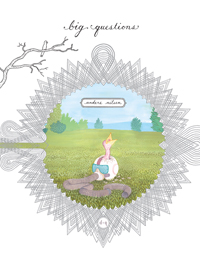 Big Questions
Big Questions
by Anders Nilsen
Drawn and Quarterly, 2011
658 pages / $44.95 Buy from D&Q or Amazon
Ends beget origins in Anders Nilsen’s Big Questions, so it’s proper that we learn about the book’s genesis in its afterword. The author-illustrator tells us the 600-page graphic novel began 15 years ago as a workshop exercise meant to incite new illustration tactics. The assignment required that the artist draw an object 60 times on 60 separate sheets of paper in one hour. In Nilsen’s case, a narrative hatched while he moved through his 60 iterations (of what he doesn’t say). He reveals that the emergent events were about “a lost soldier in a barren landscape, a group of birds, and a plane crash.” And though the characters, landscape, and frames all become more complex and more thoughtfully wrought as the book assembles itself around you, much of the narrative stays as it was when it sprang from Nilsen’s workshop piece. Big Questions in completed form houses a fable-like tale, told in discreet scenes, about finches who eat seeds and ask questions; a flat-to-rolling landscape that’s unpeopled except for a grandmother and her probably slow grandson, the idiot, both of them ostensibly mute; things that go missing; a bomb that explodes and occasions more questions; a plane that crashes (yes, more questions); and a mysterious, somnolent pilot who emerges from that plane.
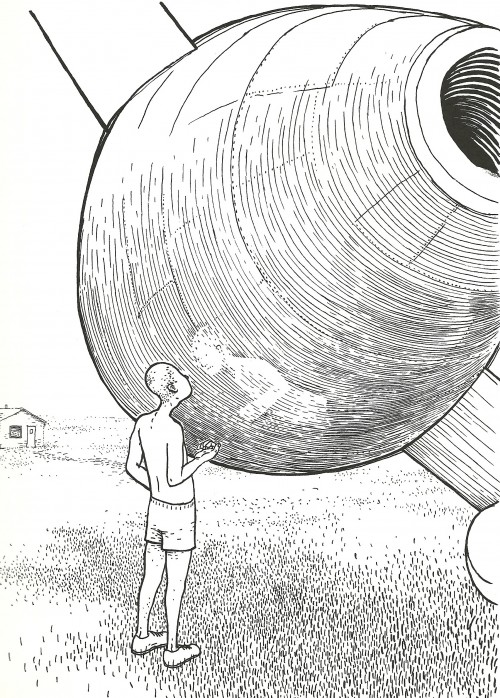 The full-color covers and flaps, the Spirograph-like radial ornamentation on interstitial pages, the physical bigness of the book—these elements of the presentation of Big Questions make it a real joy to handle and explore. But Nilsen’s storytelling aesthetic is just as satisfying. He manipulates both the time of the narrative and the space in which it takes place in an unmissably filmic way. Most noticeably, duration in this movie-like world can be deranging because the great number of pages belies the actual passage of time, which amounts to only a few days. The narrative, crystallized, is 10 or so events; the heft of each of these seems commensurate with the amount of action and movement it contains, so that the simple introductory scenes of quizzical birds take up only a few pages, while some of the later and more climactic incidents seat themselves in stacks of 30 or 40 pages. As for the book’s visually cinematic aspects, there are establishing shots and near-montages, there are moments when characters look into the narrating eye, there are stippled dissolves between sections, and there are voiceover passages in which a bubble-less monologue appears over flashback frames. And understand that both the plain and the plane are important to the presentation. The novel’s only setting is a broad plain that recommends itself for silent, mood-heavy topographical interludes. The pilot’s plane proleptically drapes its shadow on the old woman’s house in a full-page frame long before we hear any talk about its arrival, and in back-to-back three-page spreads it appears in wreckage still frames that force-feed us its gravity. And lastly the story itself is a planar accumulation of scenes, much of whose action takes place simultaneously.
The full-color covers and flaps, the Spirograph-like radial ornamentation on interstitial pages, the physical bigness of the book—these elements of the presentation of Big Questions make it a real joy to handle and explore. But Nilsen’s storytelling aesthetic is just as satisfying. He manipulates both the time of the narrative and the space in which it takes place in an unmissably filmic way. Most noticeably, duration in this movie-like world can be deranging because the great number of pages belies the actual passage of time, which amounts to only a few days. The narrative, crystallized, is 10 or so events; the heft of each of these seems commensurate with the amount of action and movement it contains, so that the simple introductory scenes of quizzical birds take up only a few pages, while some of the later and more climactic incidents seat themselves in stacks of 30 or 40 pages. As for the book’s visually cinematic aspects, there are establishing shots and near-montages, there are moments when characters look into the narrating eye, there are stippled dissolves between sections, and there are voiceover passages in which a bubble-less monologue appears over flashback frames. And understand that both the plain and the plane are important to the presentation. The novel’s only setting is a broad plain that recommends itself for silent, mood-heavy topographical interludes. The pilot’s plane proleptically drapes its shadow on the old woman’s house in a full-page frame long before we hear any talk about its arrival, and in back-to-back three-page spreads it appears in wreckage still frames that force-feed us its gravity. And lastly the story itself is a planar accumulation of scenes, much of whose action takes place simultaneously.
Despite the narrative’s overall straightforwardness, the large quantity of characters can make for confusion at first. The finches each have basically the same line-drawn physicality, so we count on their exchanges with one another to let us know who’s who—especially in the book’s early pages, when their principle activities are eating and flying and landing, and their spoken philosophical views aren’t yet defined. It may have been in anticipation of this simple difficulty that Nilsen included an illustrated and captioned cast of characters on the book’s flaps. Perfect for quick reference, these show stills from the novel and say briefly what each character’s role is. And many of the scenes helpfully announce themselves with eponymous title treatments, some drawn right into the first panel, others written in simple script on the sky or on a banner. There are scenes that don’t have titles at all, except for in the table of contents, whose navigational aid contextualizes events that are floatingly vague on their own. For instance, Nilsen visually codes the frames of the pilot’s elaborate and frequent dreams, but for the occasion when he leaves one uncoded, we have the table of contents to reassure us that the section we’re reading is “The Pilot’s Dream.”
After settling your questions about the book’s anatomy, there’s the matter of why the birds think philosophically. In the title page’s illustration, below a lightbulb-studded “BIG QUESTIONS” sign, are the cursive words “or Asomatognosia: whose hand is it anyway?” Asomatognosia puts the body in question. It’s a neurological disorder whose symptoms are misrecognizing, forgetting about, or neglecting one’s physical presence. The question “whose hand is it anyway?” points to an uncertainty about agency and action; this is especially true if we pay attention to the obvious suggestion that the unnamed hand is the hand of fate. Asomatognosia doesn’t appear by name in the novel’s main pages—but, implicit in most of the birds’ questions, it’s the novel’s armature: There’s always the dilemma of how one should act, or if one should act at all, when poised between malaise and a teleology beheaded. The Beckettian and still-spare beginning pages show a handful of finches lamenting aloud the seeds they’re damned to eat daily. But doggedly they go on. The scene ends with a textless illustration of the birds eating those same seeds, and the emphatic banality of the image implies that thinking, asking big questions, is what might excuse the finches from emptiness.
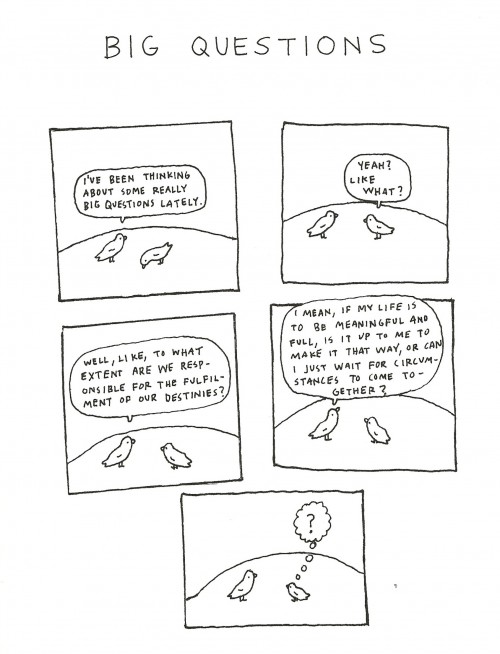
And so the novel’s beginning is configured as the locus of the birds’ questions, which concern topics—big, indeed—like meaninglessness, free will, and fate. Frustratingly, the first question in the narrative proper is unattributed; we don’t know which bird asks it. It appears in a sketch that shows two unnamed companions against a blank background. One says to the other, “I’ve been thinking about some really big questions lately.” The same bird goes on to ask, “I mean, if my life is to be meaningful and full, is it up to me to make it that way, or can I just wait for circumstances to come together?” Its interlocutor responds, “That second thing you said.” The first bird closes the scene with, “Yeah, I think so too.” The volley’s funniness seems meant to skirt seriousness but really is quite tactical: The question at hand is the one that establishes the extended existential uneasiness of Big Questions, and if we’re to take the second bird’s response as any sort of foretelling, we can guess that the question will remain unanswerable.
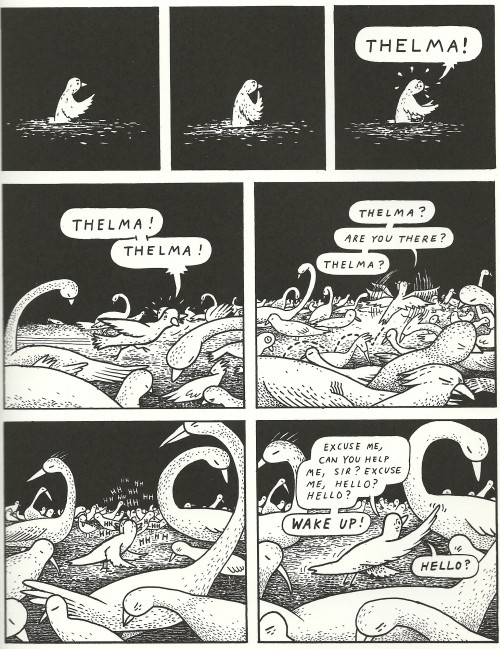
On another early page—this one’s vignette occupying a pleasing cluster of white circles on a black background—the finch Morris tells his partner Louis that the world is recently revealing to him that “our only hope is to accept that we have no control over our lives” and that we must “let events take their course and savor the results.” He closes by saying he wants dessert. Because this is the second such disengaged dialogue closer, it’s tempting to think Nilsen is constructing a series of glib, zeitgeist-conscious non sequiturs. But the birds’ friend Algernon flies into the scene with another question, which saves the mood from cool aloofness. Algernon asks, “Have you guys seen Thelma today?” and explains that she, his mate, has disappeared along with the tree they share. Neither Louis nor Morris has seen Thelma. The scene ends. And this question, the first one like it, is for the reader as well as for the characters. Much in the same way that the finches’ first metaphysical inquiry is our way into their preoccupations, the Thelma conundrum lets us know that narrative holes can make Alices of us.
Though the puzzlement in the book’s early scenes holds up the following 500 pages’ architecture, it also serves characterization. When the bomb falls on the birds’ prairie, the finch named Charlotte immediately announces that it’s an egg and says the plane that dropped it is a bird. “You saw the giant bird just now,” she says to two others, Curtis and Betty. “Look at the shape, the hard shell…and it’s warm. It’s practically humming. It could have fallen anywhere. There’s nothing for miles, but it came to us. Clearly, it was delivered into our care.” Charlotte then conscripts Betty to guard the egg while she goes off to pontificate to the others about its divineness. And when Charlotte returns, she declares that the egg is a kind of epistemological trial, introducing a claim that both enriches and haunts the rest of the novel. “We can’t know for certain what this is,” she says, “but what can anyone know with certainty?” She forcefully concludes the scene by reestablishing the egg’s metaphysical significance: “Maybe it was an accident, but maybe it was a test. Maybe it’s a message…. But we clearly have an obligation to act with humility and gratitude for the chance we’ve been given. I mean, we live in a special time, don’t you think?” Curtis responds with skepticism to Charlotte’s assumptions, and this is the beginning of a philosophical division that’s central to the book: On one side is Charlotte the recklessly fervent believer, and on the other is Curtis the skeptic.

Between these two is Betty, who’s a conflicted Charlotte loyalist. Before the high-casualty egg explosion, she has a proleptic dream in which she warns the other birds that it’s dangerous. After it detonates, her dilemma is about whether she should’ve believed the dream and saved some finches by discouraging them from egg worship. An egg is potential life, and the one in the finches’ possession is metaphysically important because it’s a potential answer. It portends something, but we never know what. All we observe is the birds’ frenzy over its gestative goodness. Later, when Charlotte is killed in the egg’s blast (I’m not giving anything away; it’s on the front flap), the novel takes the look of a simple fable about the dangers of zealous certainty in response to unanswerable questions. But her ghost appears and states her apologetics to Betty in heavenly light, providing the oration that retrieves the book from moral-of-the-story didacticism. “You have to trust what you feel,” says Charlotte’s spirit to a Betty embittered by the blast’s carnage. “Certainty is a mirage. Certainty is the refuge of small minds. At some point you have to just trust yourself and act. I feel this so strongly.” Significantly, the title of the vignette is “Charlotte Evangelista: A Defense of the Faith.” So we know that we’re in the presence of a character who even after death has not learned a moral—let alone one that a reader ought to carry away from his/her reading.
Considered as a bomb, the egg is potential destruction. But it’s also a beginning insofar as its blast is a thinker’s Big Bang, an originary event that marks the dissolution of existing questions and the insertion of new ones in their cavity. The finches’ post-explosion conundrum comes when a plane crashes into the grandmother’s house. The pilot who exits the plane’s cockpit is immediately a cause for division among the birds: Some of them believe he’s another gift; others say the bomb that preceded him makes his divinity impossible. All flying things must come from eggs, say the believing finches—but this conviction comes from a lexicon that can’t account for an existence beyond its users. The birds are from eggs; innocently naïve, they suspect the pilot is too, and they call him a hatchling. There’s dramatic irony here: We understand the real taxonomy, which the finches’ repertoire precludes. This privileged knowledge (that the man is not a hatchling and his plane is not a bird) could offer readerly superiority, but Nilsen deftly withholds it. He instead uses the pilot to serve up reader-specific questions—about the swans in the pilot’s dreams, the cavernous unconscious-qua-Platonic-cave he apparently shares with Algernon, the absence of language between the finches and him, his relation to the egg. Given these uncertainties, Big Questions isn’t easily called a fable: The answers to the finches’ quandaries are clear enough to us, but the narrative leaves us to do some deciphering for ourselves. And the unavoidable pressure of our own bafflement subverts whatever smugness we might have about the finches’ dear uncertainty and sweet philosophizing. Questions aren’t just for the birds.
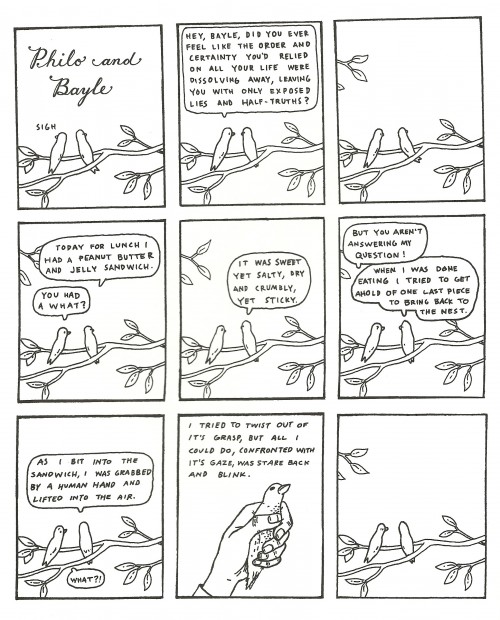
Much earlier in the novel, the finch Philo wants his friend Bayle to tell him whether “the order and certainty you’d relied on all your life were dissolving away, leaving you with only half-truths,” and Bayle’s blithe reply is, “Today for lunch I had a peanut butter and jelly sandwich.” What here seems like another non sequitur turns out to launch an important component of the narrative, Bayle’s interaction with the idiot. Bayle continues his lunch anecdote with an unshakable awe that seems to dwarf Philo’s puny musings: “When I was done eating I tried to get ahold [sic] of one last piece to bring back to the nest. As I bit into the sandwich, I was grabbed by a human hand and lifted into the air.” The next panel functions as a delightful flashback image of Bayle in the idiot’s hand, with a caption saying that all he could do was “stare back and blink.” Stunned, Philo wants to know if the human tried to eat Bayle, who explains that the grandmother approached and he flew away. Bayle’s tacit question—Can I exist with this human?—is important because it contains neither the bird-centric vocabulary Charlotte uses to describe the world nor the dissembled certainty that characterizes her faith. Indeed Bayle’s fascination, operating as it does outside of the two existing philosophical schools, represents a kind of third party, a position that’s independent of the new bomb hubbub. Bayle daringly makes himself the idiot’s friend, neglecting the duties of partisanship and enacting a bravery that promises interspecies communion instead of righteousness or rightness.
Throughout Big Questions, there’s the threat that the pedestrian will overwhelm the metaphysical. Alongside worries about fate and agency, for example, are arguments about who will eat the last of the dead grandmother’s doughnuts. But near the book’s end there’s an important reversal: When the pilot turns out to be not so benevolent, the finches come out of their cultish fever and go on existing: They build nests, they eat seeds. And they end their divided obsession over the bomb and the pilot; humbled, they move to re-colonize the habitat those presences have invaded. Following after Bayle, they live with the idiot, who’s without both speech and questions. The idiot’s wordless injunction to the finches is one that asks dumb simplicity, a new and touched beheadedness. So while the novel intimates the danger of neglecting questions, of not asking, it also congratulates the minds—Bayle’s and the idiot’s—that seek to inhabit the sublime rather than insult it with careless worship or cynical dismissal.
***
Jared Woodland lives in Los Angeles.
Tags: Anders Nilsen, Big Questions, jared woodland

great writeup. i look forward to reading it.
nilsen’s monologues for calculating the density of black holes is a slamdunk.
such fearless use of print space.
Probably my favorite book of 2011. I’d been waiting for the collected edition for a long time, as the early serialized comics are really hard to track down. I read the whole thing in one night. About to pick it up again for a reread.
http://lnk.co/IL4JS